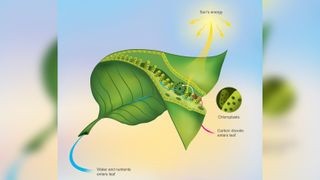Have you ever stopped to wonder why the fields, parks, and lawns around us are predominantly green? The color of grass is so common that we rarely question it, but the reason behind this vibrant hue is a fascinating journey into the world of plant biology and light. The simple answer lies in a pigment called chlorophyll, but the complete explanation delves into the realms of wavelengths, photosynthesis, and the intricate workings of plant cells.
To understand why grass is green, we need to explore chlorophyll. This pigment resides within tiny structures in plant cells called chloroplasts. Chlorophyll molecules are complex, featuring a magnesium ion at their core, bound to a large organic nitrogen molecule known as porphyrin. Interestingly, the name “chlorophyll” itself originates from the Greek word “chloros,” meaning “yellowish-green.”
 Diagram illustrating photosynthesis within chloroplasts in a leaf
Diagram illustrating photosynthesis within chloroplasts in a leaf
So, how does this “yellowish-green” pigment make our lawns appear vividly green? The secret lies in how chlorophyll interacts with light. Visible light, which is part of the electromagnetic spectrum, is composed of various colors, each with a different wavelength. When light strikes grass, chlorophyll molecules absorb specific wavelengths of this light most effectively. Chlorophyll excels at absorbing red and blue light wavelengths.
However, chlorophyll is less efficient at absorbing green light, which falls in the middle of the visible spectrum. Instead of being absorbed, green light is reflected back. This reflected green light is what reaches our eyes, and consequently, we perceive grass as green. It’s not that grass is inherently green in pigment, but rather it appears green because of the wavelengths of light it reflects.
But chlorophyll’s role extends far beyond just giving grass its color. It is crucial for a fundamental process called photosynthesis. Photosynthesis is how plants convert light energy into chemical energy in the form of sugars, which they use as food for growth and survival. Within the chloroplasts, chlorophyll captures the energy from sunlight. This captured light energy is then utilized to convert carbon dioxide from the air and water from the soil into glucose (sugar) and oxygen.
In essence, the green color of grass is a visual indicator of chlorophyll at work, diligently capturing sunlight to power photosynthesis. This process not only sustains plant life but also produces the oxygen we breathe, highlighting the vital role that this green pigment plays in our ecosystem. The next time you see a lush green lawn, remember that you’re witnessing a remarkable interplay of light, biology, and the essential process of life on Earth.